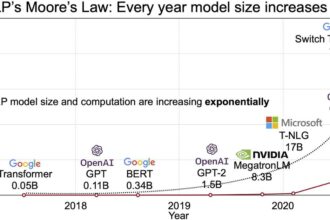Costs of AI Stats: Understanding the Financial Impact of AI Development — The costs of AI development and implementation are rapidly increasing, driven by soaring computing expenses and complex infrastructure needs. This growing financial burden is reshaping how companies approach AI innovation and scaling. Understanding these costs is vital for organizations planning to invest in AI solutions.
Table of Contents
ToggleSoaring Computing Costs Challenge AI Innovation
Companies face unexpectedly high computing costs while adopting generative AI technologies. These rising expenses risk slowing innovation and transformation efforts in many industries. Cloud provider fees, training complex models, and running AI workloads contribute heavily to these climbs.
For major AI firms like OpenAI, substantial expenditures accompany explosive revenue growth. OpenAI’s August 2024 earnings hit USD 300 million monthly, prompting a USD 6.6 billion funding round at a USD 157 billion valuation. This capital backs high operating costs and ambitious growth plans.
Insights from IBM Institute for Business Value
IBM’s Institute for Business Value (IBV) highlights the economic hurdles executives face amid the AI surge. Their report states computing costs are projected to increase by 89% from 2023 to 2025, with generative AI as the key driver for 70% of surveyed executives.
Cost concerns are so significant that every executive surveyed has postponed or canceled at least one AI initiative. These findings underscore the cost barrier to scaling AI beyond experimentation.
Challenges in Scaling AI Solutions
Jacob Dencik, IBV’s Research Director, notes that as organizations move from pilots to production-scale AI, cloud and compute costs become critical hurdles. He emphasizes that the financial viability of AI applications will ultimately dictate their business impact.
Even technically feasible AI projects could falter if expenses to train or operate models outweigh expected benefits. This economic tension defines current AI adoption dynamics.
Strategic Financial Risks in AI Adoption
UST’s Chief AI Architect, Adnan Masood, describes today’s AI investments as a strategic inflection point. Innovation carries substantial financial risk. Companies must decide whether to invest heavily in AI breakthroughs or risk falling behind in this competitive landscape.
Managing Costs with Hybrid Cloud Architectures
To address rising expenses, many organizations adopt hybrid cloud strategies. This approach balances workloads across public cloud and private resources, optimizing cost efficiency.
- Hybrid clouds provide financial transparency and control.
- They enable workload placement in the lowest-cost environments.
- They offer visibility into where costs arise, facilitating better budgeting.
Using Generative AI for Efficiency Gains
Generative AI also supports cutting costs by improving coding efficiency and optimizing infrastructure design. Some estimates suggest coding improvements can reduce application energy consumption by up to 50%. Generative AI helps optimize data center layouts and server design, enhancing compute resource efficiency.
Additional Techniques to Reduce AI Expenses
Masood emphasizes techniques like large language model (LLM) routing, which directs requests to the most cost-effective model based on complexity and performance. Quantization and fine-tuning smaller models accelerate processing while lowering hardware needs.
Complexity and Cost of AI Models
Dencik advises a pragmatic model approach. Not every task requires large language models. Smaller models trained on high-quality data often deliver equal or better performance with lower costs. Reusing and fine-tuning existing models often beats building new ones from scratch.
Multimodal AI Deployment for Cost Efficiency
Implementing multimodal and multi-model AI platforms lets organizations use diverse AI types depending on task requirements. This approach enhances cost-effectiveness and maximizes AI value.
Environmental Considerations and AI Costs
The environmental impact of AI is a hidden cost, primarily from energy consumption in data centers. Emerging “green ops” initiatives focus on reducing cloud usage impact. Awareness of sustainability factors increasingly influences total cost of ownership.
Typical AI Development Cost Components and Ranges
| Cost Category | Estimated Range (USD) |
|---|---|
| Custom AI Model Development & Training | $50,000 – $500,000+ |
| Fine-Tuning Pre-trained Models | $10,000 – $100,000 |
| Data Labeling & Annotation | $10,000 – $250,000+ |
| Cloud AI Services (Annual) | $5,000 – $100,000 |
| On-Premise GPUs (Hardware) | $50,000 – $1 million |
| AI Talent Salaries (Annual) | $80,000 – $300,000 per professional |
| Model Monitoring & Updates | $10,000 – $200,000 annually |
| Compliance & Security | $5,000 – $50,000 |
Average Project Costs and Timelines
- Simple AI projects: $5,000 to $20,000
- MVP development spans 1 to 3 months
- Complex custom AI solutions: $200,000+ and can exceed $500,000
- Hourly AI integration services: $25–$50
Emerging Trends Affecting AI Costs
- Rise of generative AI models significantly drives compute and development costs.
- Model compression and edge AI technologies reduce reliance on expensive cloud computing.
- No-code and low-code AI platforms lower barriers, cutting development expenses by up to 40%.
- Regulatory compliance adds new financial layers to AI projects.
- Industry-specific AI solutions vary widely: healthcare, FinTech, and manufacturing have distinct cost profiles.
Smart Budgeting Strategies
- Adopt phased implementation with pilot projects to test feasibility and control spending.
- Leverage open-source AI frameworks such as TensorFlow and PyTorch.
- Utilize cloud solutions to avoid costly infrastructure.
- Invest in AI governance early to minimize future legal risks.
- Implement automation in model monitoring using MLOps tools.
Key Market Statistics
- Global AI development market is projected to reach roughly $1.8 trillion by 2030.
- AI deal volume hit 1,245 transactions by the end of 2024.
- Average computing costs will rise approximately 89% from 2023 to 2025.
Key Takeaways
- AI computing costs are sharply increasing, mostly due to generative AI.
- Major players face high funding needs due to soaring expenses.
- Hybrid cloud and efficient coding help manage and reduce costs.
- Smaller, task-specific models can reduce complexity and cost.
- Environmental impact is a growing cost consideration with AI systems.
- Common AI project costs range widely, with pilot projects starting ~$5,000 and custom solutions exceeding $500,000.
- Smart budgeting strategies and phased projects help optimize AI investments.
- Regulatory compliance and talent shortages add cost pressures.
Costs of AI Stats: the Price Tag on Innovation
Today’s companies are diving headfirst into the AI revolution, but soaring computing costs threaten to stall their momentum. Understanding the costs behind AI—ranging from development and deployment to sustainability—is crucial to keep innovations afloat without sinking budgets.
Let’s take a deep-dive into the numbers, strategies, and real-world examples illuminating the complicated financial landscape of AI in 2025 and beyond.
Computing Costs Skyrocket: The Hidden Barrier
Anyone venturing into generative AI quickly hits a surprising bottleneck: computing costs. These expenses are climbing so fast they risk derailing many promising projects. According to IBM’s Institute for Business Value (IBV), computing costs will leap nearly 89% from 2023 to 2025.
This spike comes largely thanks to generative AI. 70% of executives surveyed signal chatty AI tools like GPT and Claude as a major cause of soaring cloud bills. Yet, ironically, the true scale of these costs may not have fully landed yet, since many firms are still experimenting rather than scaling.
“The cost of computing… will be a key issue to consider, as it is potentially a barrier for them to scale AI successfully.” — Jacob Dencik, IBV Research Director
So, a splashy, small pilot project might seem affordable. But when companies race to roll out AI at scale, those cloud invoices—and hardware investments—can balloon alarmingly.
Economic Pressure on AI Giants: OpenAI’s High-Stakes Balancing Act
Even AI giants feel the heat of these rising costs. OpenAI, known for its GPT models, reported terrific growth, with monthly revenue hitting $300 million by August 2024. Yet, to sustain innovation and infrastructure, they raised $6.6 billion in October at a staggering $157 billion valuation.
This underscores a sobering reality: even the most successful AI players wrestle with runaway expenses. Heavy investments in computing power—and the complexity of training models like GPT-4 and Google’s Gemini—are expensive stakes in the competitive AI arms race.
Breaking Down AI Development Expenses
Costs vary widely depending on the project scale and AI sophistication.
- Simple AI projects like chatbots, can start as low as $5,000.
- MVP (Minimum Viable Product) developments typically range from $30,000 to $60,000.
- Custom AI solutions often surpass $100,000, with highly specialized or large-scale models soaring beyond $500,000.
Some AI model training costs might even breach the $10 million mark in compute expenses alone.
The Main Cost Drivers Include:
- AI Model Development & Training: Custom models, data collection, annotation, and fine-tuning can require hundreds of thousands, especially for industry-specific algorithms with high accuracy demands.
- Cloud and Infrastructure: Cloud AI services vary from $5,000 to $100,000 yearly; high-end GPUs cost between $50,000 and $1 million.
- Talent & Development: Hiring AI engineers and data scientists costs $100,000–$300,000 yearly per expert. Consulting fees can reach $200,000.
- Maintenance: Continuous model updates, compliance, legal audits, and monitoring tally up to $10,000–$200,000 annually.
Scaling AI Is No Picnic
It turns out running a few AI demos isn’t the expensive part — it’s going big. As companies ramp up, costs explode. This is especially true if they don’t optimize hardware and cloud usage.
Jacob Dencik sums it up beautifully: “Even if something is technically feasible… if the business case doesn’t stack up because of costs, we won’t see the impact people anticipate.”
Financial Risks Become Strategic Crossroads
UST’s Chief AI Architect, Adnan Masood, calls this a “strategic inflection point.” Innovation now demands big bets with heavy financial risk. Push AI forward recklessly, and budgets may break. Hold back, and risk losing out in the AI arms race.
Masood suggests creativity in cost management, including tactics like LLM routing (smartly directing queries to the best-fit model) and shrinking large language models using quantization to lower hardware demand.
Hybrid Cloud: The Middle Path to Manage Costs
Hybrid cloud architectures are emerging as popular cost-control mechanisms. They allow organizations to juggle workloads between public and private clouds, finding the cheapest environment without sacrificing performance.
This approach provides transparency—a dashboard to spot where money leaks occur and optimize usage. It’s not a magic wand, but it gives organizations the power to tame the cost beast proactively.
Generative AI as Both Problem and Solution
Curiously, generative AI itself can be used to chip away at its own colossal energy footprint. Clever coding can slash the energy use of AI-powered apps by up to 50%. Organizations are turning to AI for optimizing data centers and server designs.
Dencik notes, “Generative AI can support the efficiency of your computing and compute resources—it can be part of the solution.”
Model Complexity: Bigger Isn’t Always Better
Not every task demands the might of gargantuan models like GPT-4. Often, smaller models outfitted with quality data outperform or match larger ones at a fraction of the cost. Fine-tuning existing models is frequently smarter than building new ones from scratch.
A wider palette of models and modalities, chosen strategically, can maximize business value and minimize waste.
Counting Environmental Costs
Beyond dollars, AI’s energy appetite carries environmental heft. These are hidden costs bundled into soaring cloud payments. Emerging “green ops” strategies seek to minimize AI’s carbon footprint, optimizing cloud resource use to reduce emissions and satisfy growing eco-conscious stakeholder expectations.
Industry-Specific Price Tags
Different sectors wrestle with distinct cost hurdles. For example:
- Healthcare AI: $200,000 to $2 million, driven by strict regulatory compliance like FDA and HIPAA.
- FinTech AI: $100,000 to $1.5 million, focused on fraud detection and risk analysis.
- Manufacturing AI: $150,000 to $2 million, for predictive maintenance and quality controls.
Compliance, security, and domain complexity drastically impact budgets.
Summary of AI Project Costs and Timelines
| AI Solution | Estimated Cost Range |
|---|---|
| MVP Version | From $20,000 |
| Advanced Tailored Solution | From $60,000 |
| Domain-Specific AI Assistant | $20,000 – $30,000 |
| Basic Facial Recognition/ Object ID | ~$15,000 |
| Advanced Facial Recognition | From $200,000 |
| Basic AI-driven Recommendations | $10,000 |
| Custom AI-driven Recommendations | $200,000 |
| Suspicious Activity Detection (Basic) | $30,000+ |
| Suspicious Activity Detection (Mid-level) | $100,000+ |
| Suspicious Activity Detection (Advanced) | $300,000+ |
| Trend Forecasting & Decision Optimization (Basic) | From $20,000 |
| Trend Forecasting & Decision Optimization (Advanced) | From $40,000 |
Smart Budgeting Strategies: Keeping AI Costs in Check
Cutting AI costs isn’t just about slashing spend; it’s about spending smartly.
- Employ phased approaches: pilot projects start around $50,000 to $150,000 to validate hypotheses.
- Leverage open-source frameworks such as TensorFlow, PyTorch, and Hugging Face to avoid licensing fees.
- Choose cloud AI instead of on-prem hardware to reduce upfront investment.
- Invest early in governance and compliance to sidestep expensive audits later.
- Automate maintenance with MLOps tools like MLflow and Kubeflow for efficient retraining and monitoring.
- Use MVPs and proofs of concept to avoid costly misfires.
- Partner with expert outsourcing teams in cost-effective locations—sometimes being global pays off!
- Stay agile: adjust project scope quickly to avoid budget overruns.
The Market Forecast: AI’s Growing Role in the Global Economy
The AI development market is exploding, projected to rake in $1.8 trillion by 2030. With over 1,200 AI deal transactions recorded in 2024, the stakes—and the investments—are enormous. Managing costs will be a prime differentiator between winners and also-rans.
CEOs who master the art of cost control can run their businesses like high-performance machines, harnessing the latest tech—but without the financial drag.
In Conclusion: Is AI Worth Its Price Tag?
Yes, but only if you play it smart. AI holds promise to transform industries—but unchecked cost inflation, if ignored, could put innovation on ice. Organizations face a complex balancing act: investing enough to lead in AI, yet staying savvy to avoid financial risk.
Whether it’s employing hybrid clouds, tuning model sizes, or riding the wave of no-code platforms, savvy cost management strategies will determine who rides the AI wave—and who wipes out.
In the end, understanding these costs and planning accordingly transforms AI from a costly gamble into a powerful engine of progress.
What drives the rapid increase in AI computing costs?
The surge in generative AI use and complex model training heavily raise cloud and compute expenses. IBM reports expect an 89% cost rise by 2025, with 70% of executives citing generative AI as a major factor.
How are companies managing soaring AI costs strategically?
Many adopt hybrid cloud solutions for cost control. This approach offers oversight on workload expenses and helps optimize resources in the cheapest environments, curbing runaway cloud bills.
What are typical AI development cost ranges for businesses?
- Basic AI projects can start at $5,000.
- Custom models generally cost $20,000 to $100,000+.
- Full software development often exceeds $60,000 and can surpass $200,000.
- Advanced, highly customized AI solutions may go beyond $500,000.
How can AI itself help reduce its computational costs?
Generative AI can enhance coding efficiency, cutting energy consumption up to 50%. It also optimizes data center designs and server layouts to boost computational efficiency.
Why might smaller AI models sometimes be more cost-effective?
Smaller, well-trained models on quality data can perform as well or better than large models, lowering training and compute costs. Selecting and fine-tuning models carefully avoids unnecessary expenses.




